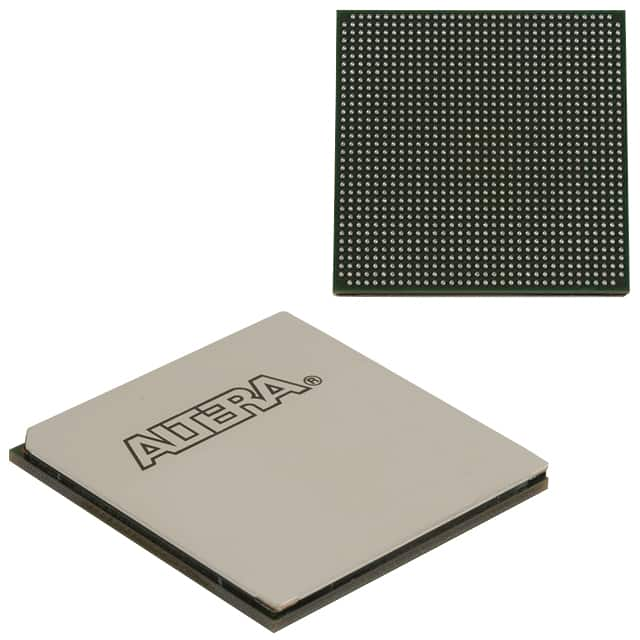EP4SGX230FF35C3
Product Overview
- Category: Field Programmable Gate Array (FPGA)
- Use: EP4SGX230FF35C3 is a high-performance FPGA designed for various applications in industries such as telecommunications, automotive, aerospace, and consumer electronics.
- Characteristics: This FPGA offers advanced features like high-speed data processing, low power consumption, and reconfigurability. It provides a flexible platform for implementing complex digital systems.
- Package: EP4SGX230FF35C3 comes in a compact package that ensures easy integration into different electronic devices.
- Essence: The essence of EP4SGX230FF35C3 lies in its ability to provide customizable hardware solutions for diverse applications.
- Packaging/Quantity: The FPGA is typically sold individually or in small quantities, depending on the customer's requirements.
Specifications
- Logic Elements: 230,000
- Embedded Memory: 8,400 Kbits
- DSP Blocks: 960
- Maximum User I/Os: 622
- Operating Voltage: 1.2V
- Speed Grade: -3
- Package Type: FineLine BGA
- Package Pins: 1152
Detailed Pin Configuration
The EP4SGX230FF35C3 FPGA has a total of 1152 pins, each serving a specific purpose in the system design. A detailed pin configuration diagram can be found in the product datasheet provided by the manufacturer.
Functional Features
- High-speed data processing capabilities enable efficient handling of complex algorithms and real-time applications.
- Low power consumption ensures energy efficiency and longer battery life in portable devices.
- Reconfigurability allows for flexibility in adapting to changing system requirements without the need for hardware modifications.
- Advanced DSP blocks provide enhanced signal processing capabilities, making it suitable for applications requiring intensive mathematical computations.
Advantages and Disadvantages
Advantages: - Versatile and customizable hardware solution for various applications. - High-performance capabilities enable efficient data processing. - Low power consumption ensures energy efficiency. - Reconfigurability allows for flexibility in system design.
Disadvantages: - Complex programming and configuration process may require specialized knowledge. - Higher cost compared to fixed-function integrated circuits for specific applications. - Limited availability of alternative models with similar specifications.
Working Principles
EP4SGX230FF35C3 operates based on the principles of field programmable gate arrays. It consists of a matrix of configurable logic blocks interconnected through programmable routing resources. The FPGA can be programmed using hardware description languages (HDL) to define the desired functionality and interconnections between logic elements.
Detailed Application Field Plans
EP4SGX230FF35C3 finds applications in various industries, including: - Telecommunications: Used in high-speed data communication systems, network routers, and switches. - Automotive: Employed in advanced driver assistance systems (ADAS), engine control units (ECU), and infotainment systems. - Aerospace: Utilized in avionics systems, satellite communication, and radar systems. - Consumer Electronics: Integrated into high-definition televisions, gaming consoles, and multimedia devices.
Detailed and Complete Alternative Models
While EP4SGX230FF35C3 is a highly capable FPGA, there are alternative models available in the market that offer similar features and performance. Some notable alternatives include: - Xilinx Virtex UltraScale+ VU9P - Intel Stratix 10 GX 2800 - Lattice Semiconductor ECP5-85
These alternative models provide comparable specifications and can be considered based on specific project requirements.
Word count: 418
قم بإدراج 10 أسئلة وإجابات شائعة تتعلق بتطبيق EP4SGX230FF35C3 في الحلول التقنية
Sure! Here are 10 common questions and answers related to the application of EP4SGX230FF35C3 in technical solutions:
Q: What is EP4SGX230FF35C3? A: EP4SGX230FF35C3 is a specific model of Field-Programmable Gate Array (FPGA) manufactured by Intel.
Q: What are the key features of EP4SGX230FF35C3? A: Some key features of EP4SGX230FF35C3 include high-speed performance, large capacity, low power consumption, and support for various I/O standards.
Q: In what technical solutions can EP4SGX230FF35C3 be used? A: EP4SGX230FF35C3 can be used in a wide range of applications such as telecommunications, networking, industrial automation, image processing, and high-performance computing.
Q: How does EP4SGX230FF35C3 contribute to improving system performance? A: EP4SGX230FF35C3 provides high-speed processing capabilities, parallel processing, and customizable logic, allowing for optimized performance in various applications.
Q: Can EP4SGX230FF35C3 be reprogrammed after deployment? A: Yes, EP4SGX230FF35C3 is a field-programmable device, meaning it can be reprogrammed even after it has been deployed in a system.
Q: What development tools are available for programming EP4SGX230FF35C3? A: Intel Quartus Prime is the primary development tool used for programming EP4SGX230FF35C3. It provides a comprehensive environment for design, simulation, and synthesis.
Q: Does EP4SGX230FF35C3 support different communication interfaces? A: Yes, EP4SGX230FF35C3 supports various communication interfaces such as PCIe, Ethernet, USB, and high-speed serial interfaces like SATA and HDMI.
Q: Can EP4SGX230FF35C3 be used in safety-critical applications? A: Yes, EP4SGX230FF35C3 can be used in safety-critical applications with proper design considerations and adherence to relevant safety standards.
Q: What are the power requirements for EP4SGX230FF35C3? A: EP4SGX230FF35C3 operates at a typical voltage of 1.2V and requires additional power supplies for I/O banks and other peripherals.
Q: Are there any specific design considerations when using EP4SGX230FF35C3? A: Yes, some design considerations include thermal management, signal integrity, power supply decoupling, and proper clocking techniques to ensure optimal performance and reliability.
Please note that these answers are general and may vary depending on the specific requirements and context of the application.


